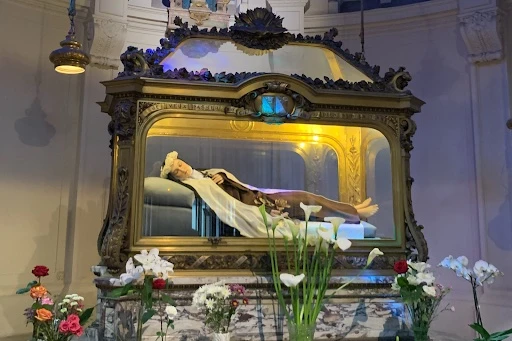House of saints: Visiting St. Thérèse of Lisieux’s home has inspired conversions
Rome Newsroom, Oct 1, 2022 / 01:00 am
Scenes from St. Thérèse of Lisieux’s beloved spiritual autobiography “Story of a Soul” come alive when walking through the rooms of her childhood home in northern France.
The red brick home in Lisieux in the region of Normandy nurtured a household of saints under one roof.
In addition to the youngest doctor of the church, Thérèse’s parents, Sts. Louis and Zélie Martin, were canonized together in 2015, and the cause of her older sister, Léonie, is currently being examined by the Vatican.
Sister Veronique, a Carmelite who assists visitors to St. Thérèse’s childhood home, told CNA that visits to the house have resulted in “many conversions.”
“People are very touched by the witness of the Martin family when they come into this house. They realize how much love was exchanged between the parents and the children,” she said.
“They feel that love and that this house has a soul.”

The Martin family settled in the house in Lisieux in 1877 after Thérèse’s mother, Zélie, died of cancer when Thérèse was only 4 years old.
Thérèse was the ninth child in the family — four of her siblings, two of whom were boys, died before she was born.
After the death of his wife, Louis Martin “educated his girls well by placing God at the forefront of the family,” Sister Veronique said.
“He went to Mass every morning and when his daughters saw their father pray, they imagined him as a saint. Truly all of the Martin girls realized that they had parents who were saints and followed their example.”
Thérèse chose her older sister Pauline as her “second mother.” When Thérèse learned that Pauline planned to enter the local Carmelite convent as a cloistered religious sister, she was very distressed and eventually became ill. Her father asked for a novena of Masses to be offered for 10-year-old Thérèse’s healing. His prayers were soon answered.

In Thérèse’s bedroom, on the second floor of the house, one can stand in the spot where a statue of the Blessed Virgin Mary smiled at Thérèse and she experienced a miraculous healing on May 13, 1883.
Thérèse recounted the event in “Story of Soul”: “I turned to my Heavenly Mother, begging her from the bottom of my heart to have pity on me. Suddenly the statue seemed to come to life and grow beautiful, with a divine beauty that I shall never find words to describe. The expression of Our Lady’s face was ineffably sweet, tender, and compassionate, but what touched me to the very depths of my soul was her gracious smile.”
With the grace of the smile from the Blessed Virgin, Thérèse was cured. The white Marian statue currently in Thérèse’s bedroom is a copy of the original, which can be found above the shrine in the Carmelite chapel in Lisieux.
Hanging on the wall in the bedroom is St. Thérèse’s real hair, cut before she entered Carmel.

The dining room contains the original kitchen table and chairs where the Martin family would gather for their daily meals. The clock on the wall is signed “Louis Martin” by Thérèse’s father, who was both a jeweler and a clockmaker.
Sister Veronique’s favorite story from the life of St. Thérèse took place near the fireplace where Thérèse received a “Christmas grace” of complete conversion at the age of 14 in 1886.
The Little Flower wrote: “I knew that when we reached home after Midnight Mass I should find my shoes in the chimney-corner, filled with presents, just as when I was a little child, which proves that my sisters still treated me as a baby.”
However, Thérèse overheard her father complaining that she was too old to behave like such a little child. Though greatly upset, she did not cry, as she would have before.
“Choking back my tears, I ran down to the dining-room, and, though my heart beat fast, I picked up my shoes, and gaily pulled out all the things, looking as happy as a queen.”
Thérèse pinpointed this moment as the time that she “regained, once for all, the strength of mind which she had lost at the age of four and a half.”
Less than two years later, Thérèse left the childhood home where she had spent 11 years of her life and entered the Carmel, where she remained until her death from tuberculosis at 24 years of age on Sept. 30, 1897. Her house has been a place of pilgrimage since 1913.
“My mission — to make God loved — will begin after my death,” she said before she died. “I will spend my heaven doing good on earth. I will let fall a shower of roses.”














